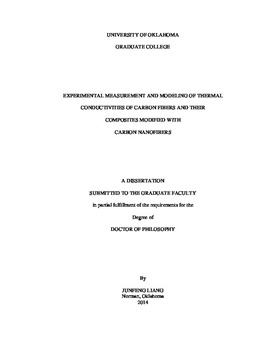| dc.description.abstract | Carbon fiber reinforced composites (CFRCs) show superior thermal performance along the fiber direction due to high thermal conductivity of carbon fiber in the fiber direction. However, these composites suffer from poor through-thickness thermal performance due to (i) low thermal conductivity of carbon fiber in its transverse direction (radial direction), (ii) low thermal conductivity of polymer matrix, and (iii) high thermal resistance at the fiber-matrix interface. One of the contemporary ways to enhance the through-thickness thermal conductivity of the composite is to incorporate carbon based nano materials such as carbon nanofibers (CNFs) through matrix and/or fiber. This work provides a systematic characterization of thermal conductivities of carbon fibers and their composites modified with CNFs using experimental measurement and theoretical modeling.
We choose 3ω method as the measurement technique is very fast, accurate, non-sensitive to convection and radiation heat loss, and its potential to measure different types of materials including carbon fibers. Therefore this research leads to the development of a number of instrumentation and procedures for measuring thermal conductivities of carbon fibers and their composites using 3ω method:
Wire-based 3ω method was implemented to measure thermal conductivity of carbon fiber reinforced epoxy composites, with its procedure and sample preparation improved.
Longitudinal thermal conductivity of individual carbon fibers was measured using specially designed 3ω setup with vacuum environment. Lu’s one-dimensional heat conduction model was incorporated to determine the longitudinal thermal conductivities of individual carbon fibers.
Radial or transverse thermal conductivity of individual carbon fiber filament was developed for 3ω method by submerging the fiber into deionized water. Accordingly a two-phase heat conduction model was developed for determining the transverse thermal conductivities of individual carbon fibers.
With the development of the aforementioned experimental setups and techniques, thermal conductivities of hierarchical carbon fibers and hierarchical carbon fiber composites were then studied. Different amount of CNFs were grown in the range of 5% to 38% by weight directly on carbon fiber tows and fabrics using chemical vapor deposition (CVD) method to produce hierarchical fibers and hierarchical composites, respectively. A consistent increase of thermal conductivities was observed with the increase amount of CNFs on the carbon fibers and their composites. Both SEM and the mass increase confirm that the enhancement of thermal conductivities stems from the increase of CNFs growth. It is also found that enhancement of thermal conductivities for carbon fibers is significantly higher than that for their composites, which indicates that defects in the composites level compromise the enhancement of thermal conductivities from the hierarchical carbon fibers.
Thermal conductivities of carbon fibers and their hierarchical composites at different temperatures from 20 °C to 60 °C (up to 100 °C for composites) were also measured. It was found that the thermal conductivities of carbon fibers moderately increase with the temperature, while the thermal conductivities of carbon fiber composites significantly increase as the temperature increase. Therefore, it is believed that the thermal conductivity of epoxy matrix and the thermal interfacial resistance between the carbon fibers and the matrix determine the temperature dependency of thermal conductivity of the composites.
Finally, a theoretical model for hierarchical carbon fiber composites was developed using effective medium theory to predict the through-thickness thermal conductivities of carbon fiber laminated composites. Parametric study has been done addressing thickness and length of the growth as well as growth pattern. Two types of growth patterns such as surface growth and full growth were investigated. It was found that the surface growth is more effective in enhancing the through-thickness thermal conductivity of carbon fiber reinforced composites. | en_US |
